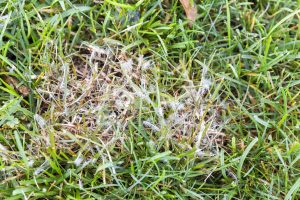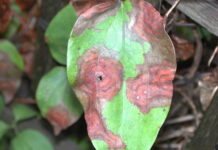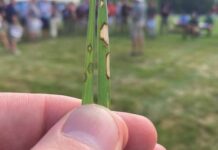There’s a reason Mark Twain said, “If you don’t like the weather in New England now, just wait a few minutes.” The harsh and erratic weather within this climate zone can wreak havoc on landscapes and create unique difficulties in ensuring the resiliency of the lawns and gardens. With Spring in full swing, Wollaston Development, a greater Boston-based site development and property design company, compiled a list of five common problems facing New England landscapes, as well as solutions for preventing and fixing them.
1. Red Thread. One of the most common fungal diseases that afflicts lawns in New England is red thread, characterized by red, circular patches of grass that occur when lawns stay too wet. It often occurs in spring or summer after snow has melted. While it won’t necessarily kill a lawn, red thread spreads quickly, and can make turf more vulnerable to other diseases and insects. Solve this lawn ailment by applying a fungicide to the patches, which stops the growth of red thread. For repeated recurrences, consider using an ongoing feeding program of the appropriate amount of nitrogen fertilizer in the fall.

2. Dollar Spot. Another grass fungus, dollar spot, appears in small, round circles on a lawn, and thrives in dry soils and moist air. Outbreaks of dollar spot increase when grass blades are wet from rain, dew, or irrigation, and roots are dry. If left untreated, these spots can merge together, forming large areas of brown grass that can be several feet in diameter. Fungicide will also treat these spots, but prevention is more effective than treatment. Dollar spot thrives on unhealthy lawns, so keep grass healthy and happy. Water deeply, but infrequently, ensuring only intermittent watering when thriving conditions for dollar spot occur.
3. Erosion. Heavy wind, poor drainage, and abundant water (especially in coastal areas) provide lots of opportunity for soil erosion to occur. While erosion solutions depend on the amount of damage that has already occurred, incorporating a dry creek bed in the area can help greatly. Simple and effective, these shallow trenches filled with varying sizes of boulders and rocks are recommended by experts to control erosion. If your client’s space doesn’t allow for a dry creek bed, another option is to install permeable pavers so excess stormwater can run back into groundwater stores. Alternative solutions include layered plantings, terracing, and more.
4. Standing Water. New Englanders are commonly frustrated with the muddy, boggy mess left behind after a harsh and unexpected storm. Standing water on a front lawn makes maintaining healthy plantings and turf much more difficult. Most often, the causes for standing water are an unlevel or impermeable lawn. If you notice stormwater stubbornly collecting on a property rather than running off to a storm drain, you may need to re-grade the landscape. Survey the natural channels, low-lying points, and drainage outlets on the property. Thatch can also cause standing water by inhibiting stormwater from permeating the ground.
5. Mushrooms. Given the region’s wet spring and summer weather, a New England lawn is the perfect place for mushrooms to build a home. These invaders thrive in damp, nutrient rich, shaded environments, and if you’ve noticed one, you’re bound to meet more. Mushrooms are especially difficult to get rid of once they begin to emerge because they form an extensive root system underground. Correcting drainage issues is often the solution.
Wollaston Development is committed to consistently delivering exceptional results in a specialized industry. From excavation and trucking, to landscape design and commercial masonry, Wollaston Development meets client’s needs at all phases of the construction process.











![[VIDEO] Dickies®: Discover Workwear That’s Anything But Uniform](https://turfmagazine.com/wp-content/uploads/2023/06/1647663814-4b1a2a7742790a9b1e97a3b963477850192e1d6a9dfba9b07214a77bae25d6e3-d-218x150.jpg)






























![[VIDEO] Dickies®: Discover Workwear That’s Anything But Uniform](https://turfmagazine.com/wp-content/uploads/2023/06/1647663814-4b1a2a7742790a9b1e97a3b963477850192e1d6a9dfba9b07214a77bae25d6e3-d-324x160.jpg)